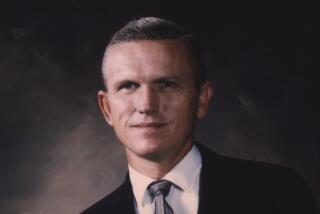Samuel Phillips; General Oversaw Moon Flights
- Share via
Samuel C. Phillips, the laconic, unflappable Air Force general who oversaw the most complex engineering project in the nation’s history when he headed the program that put the first man on the moon, has died of cancer at his Palos Verdes Estates home.
Phillips, who retired as a four-star general in 1975, was 68 when he died Wednesday, the 19th anniversary of the Apollo 14 launch that put American astronauts on the moon for the third time.
Phillips took over the embryonic Apollo Lunar Landing Program in 1964 and guided it through troubled times until 1969 when Neil Armstrong first stepped on the lunar surface during the Apollo 11 mission.
But he returned to the National Aeronautics and Space Administration in 1986 to oversee an eight-month review of NASA management procedures in the wake of the Challenger disaster.
It was not the first time that Phillips’ name had surfaced in connection with tragedy. In 1967, after the Apollo I fire killed three astronauts on the ground, a memo he had written a year earlier surfaced in which Phillips had sharply criticized NASA’s supposed failure to adequately supervise the major Apollo contractor, North American Aviation.
Phillips’ lengthy, distinguished Air Force career included tours as director of the Minuteman Intercontinental Ballistic Missile Program from 1959 to 1963, vice commander of the Ballistic Systems Division at Norton Air Force Base in San Bernardino County from 1963 to 1964, and commander of Air Force Systems Command at Andrews AFB in Maryland from 1973 to 1975.
He was an obscure colonel when he was named in 1959 to bring the Minuteman missile from its design stage through testing and into operation.
He had just returned from a Strategic Air Force Command assignment in England when he was told that the Minuteman launching schedule had been advanced a year.
His meeting of that target date brought him to NASA’s attention, and he eventually was put in charge of the lunar landing program.
At the time of his death, he was on the Committee for the Human Exploration of Space, set up by the National Research Council.
After leaving NASA to return to military assignments, Phillips became commander of the Air Force Space Program and Missile System Organization.
After his retirement, he joined TRW as vice president of the Energy Systems Management Division. He retired from the aerospace company in 1986 but continued as an adviser.
Phillips was a graduate of the University of Wyoming and received a master’s degree in electrical engineering from the University of Michigan.
His many honors included the Smithsonian Institution’s Langley Medal in 1971. He was the 14th recipient of the award, previously given to the Wright Brothers and Charles A. Lindbergh, among others, and named for Dr. Samuel P. Langley, secretary of the Smithsonian at the turn of the century
He is survived by his wife, Betty Anne, and three daughters.
A memorial service is scheduled for 3 p.m. today at the Neighborhood Church in Palos Verdes Estates. Burial will be at the Air Force Academy Cemetery in Colorado Springs, Colo., on Monday.
More to Read
Sign up for Essential California
The most important California stories and recommendations in your inbox every morning.
You may occasionally receive promotional content from the Los Angeles Times.













